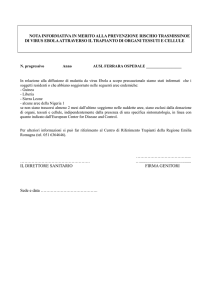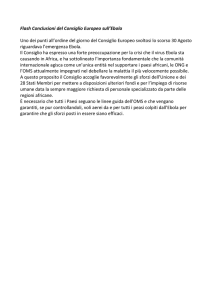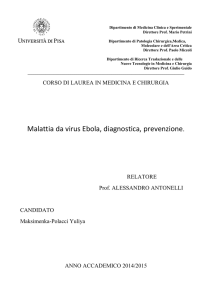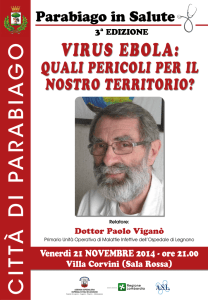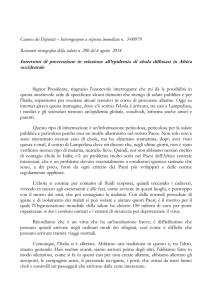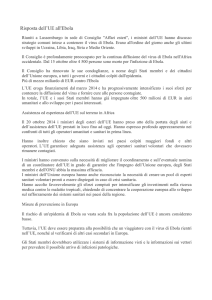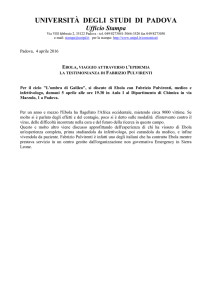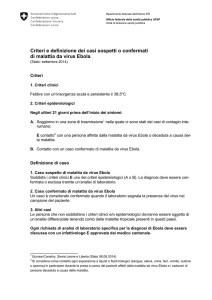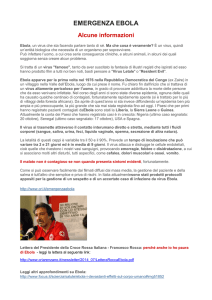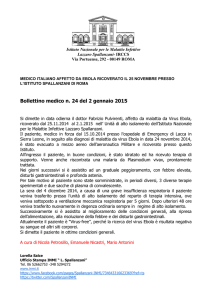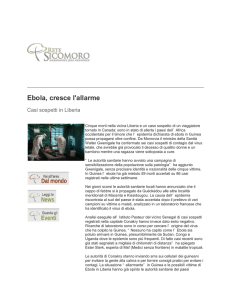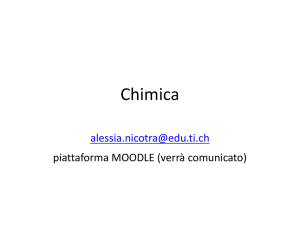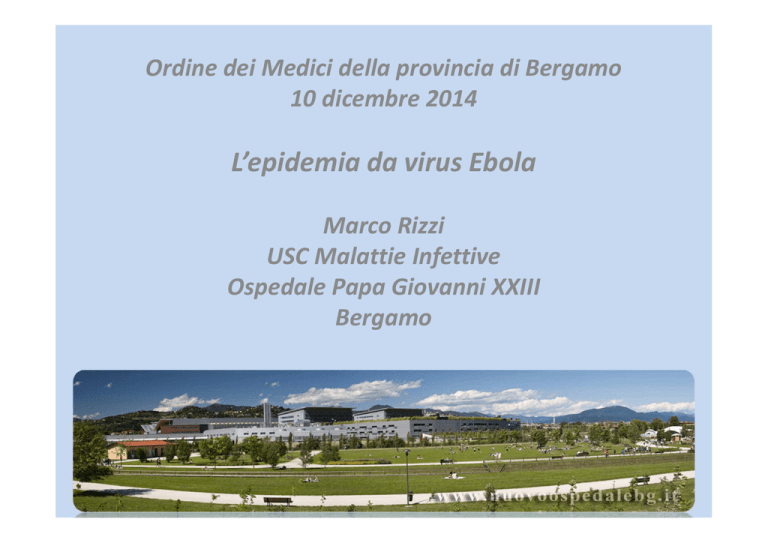
Ordine dei Medici della provincia di Bergamo
10 dicembre 2014
L’epidemia da virus Ebola
Marco Rizzi
USC Malattie Infettive
Ospedale Papa Giovanni XXIII
Bergamo
1
Ebola - 2014
2
Ebola - History
1976: several dead South-Sudan-North Zaire: near river Ebola
Dr. Margaret Isaacson, Yambuku, Zaire
Overview Ebola outbreaks 1976-2014
Ebola - 2014
5
Ebola dal 1976 ad oggi
Ebola - 2014
6
Ebola - 2014
7
Letalità
Ebola - 2014
8
Letalità
Ebola - 2014
9
Ebola - 2014
10
Ebola - 2014
11
Ebola - 2014
12
Ebola - 2014
13
Ebola - Agent
Family filoviridae – RNA virus with lipidic envelop
Different species : Ebola virus (Zaire ebolavirus);
Sudan virus (Sudan ebolavirus);
Taï Forest virus (Taï Forest e, Côte d’Ivoire e);
Bundibugyo virus (Bundibugyo e) ;
Reston virus (Reston e) -asymptomatic in humans
.
Case fatality rate 25-90 % (past outbreaks)
Ebola – transmission
Natural host:
probably (fruit)bat
(intermediate host:
non-human primate)
Human being (index case)
Human Beings
(secondary
transmission)
Natural host
hypsignatus monstrosus
Epomops franqueti
Predicted geographical distribution of the three species of Megachiroptera suspected
to reservoir Ebola virus
Pigott D M et al. eLife Sciences 2014;3:e04395
Ebola – transmission
● via direct, non-protected contact with :
- natural host or infected animal (dead or alive)
→ INITIATION of outbreak
- an Ebola patient or died corps of Ebola patient
→ secondary transmission
taking care for patient (health staff, family members) or during funerals
→ AMPLIFICATION of outbreak
● Virus is in ALL body fluids (saliva, blood, vomit, excreta, sweat, urine,
sperm, breast milk…)
● Route of infection: mucous-membranes: conjunctivae, mouth, nose;
break in the skin, sexual intercourse, breastfeeding
no contamination
during incubation time (2-21 days)
We have very strong reason
to believe that transmission
occurs when the viral load
in bodily fluids is high, on
the order of millions of virions
per microliter. This
recognition has led to the
dictum that an asymptomatic
person is not contagious;
field experience in West
Africa has shown that
conclusion to be valid.
Therefore, an asymptomatic
health care worker
returning from treating
patients with Ebola, even if
he or she were infected,
would not be contagious.
Ebola – Sensibility of the virus
Very weak
(lipidic envelop)
can easily be destroyed
• désinfection
• heating / UV
CDC recommandations:
• soap and water
• chlorine solutions
(0.05% & 0.5%)
Ebola - pathogenesis:
Mononuclear and dendritic cells are infected → immune suppression →
parenchyma cells (hepatocytes, adrenal cortical cells..) affecting the function of
liver and kidneys.
Massive release of inflammatory mediators → vascular permeability → shock
and disseminated intravascular coagulation→ coagulopathy → bleeding.
The virus can finally affect almost all organs→multiple organ failure (MOF)
The immunological response in the beginning of the infection will decide how fast
the virus will multiply and if the evolution will be catastrophic or towards cure.
Death or recovery normally takes place between 10 –14 days after onset of disease.
Ebola symptoms
• Sudden onset of fever (>37.5° axillary)
(may be absent in late stages)
• Headhache
• Muscle pain
• Arthralgia
• Abdominal pain
• Nausea/vomiting
• Diarrhea (+/-watery, bloody)
• Anorexia
• Intense tiredness and weakness
• Conjunctivitis (after 5 dys...)
• Rash
Ebola symptoms
• Hiccups
• Sore throat/dysphagia-difficult swalloving
• Chest pain
• Confusion irritability
• Seizures
• Hemorragic signs
• Hepato/splenomegalia
• Abortion/miscarriage
• Oedemas
• Shock/Deaths
Ebola outcomes
Children below
5 years of age-> CFR at
almost 70%
The age-group
with the lowest
CFR is the 514 years old.
Then CFR
increases
steadily with
age. T
MSF internal data
Ebola - 2014
25
Emory - 1
•
High-tech facilities are not essential for the safe treatment of a patient with Ebola
infection, says one of the doctors at Atlanta's Emory University Hospital, where a third
humanitarian aid worker begins treatment after being infected with the Ebola virus in
Liberia.
•
Although Emory has a Serious Communicable Diseases Unit, complete with negativepressure and dedicated laboratory facilities, Emory's Aneesh Mehta assured "We have
the unit so we used it, and we used the negative pressure for the first day, but then
turned it off," Dr. Mehta said, describing the successful treatment of the first 2 aid
workers infected in Liberia who were airlifted in August to the Atlanta facility.
•
Staff in the Emory treatment unit initially used more extensive personal protective
equipment (PPE) than is currently recommended by the Centers for Disease Control
and Prevention (CDC) because the patients had particularly contagious symptoms on
arrival, but that was temporary, he said.
Ebola - 2014
26
Emory - 2
•
But there were some unexpected roadblocks in delivering treatment. Some laboratory
technicians were reluctant to handle patient samples that needed to be sent to the
CDC, and commercial couriers, even when trained in category A handling, refused to
pick up samples from Emory, he said.
•
Waste management also became an issue, with the hospital's waste management
contractor refusing to pick up from the hospital for the first 6 days.
•
Alhough the CDC has said that sanitary sewers are adequate for the disposal of patient
waste, this was not good enough for the county watershed department, which
threatened to disconnect Emory if the Ebola virus was discharged into the sewers.
Therefore, all liquid wastes were disinfected before flushing.
•
Lab specimens were packaged in category A containers, which consisted of leak-proof
sample vessels, multiwalled packaging (including absorbent material), and rigid outer
packaging. Still, commercial couriers refused to transport anything containing the Ebola
virus from Emory to the CDC.
Ebola - 2014
27
Dallas - 1
•
Dr. Edward Goodman, an infectious disease doctor at Texas Health Presbyterian
Hospital in Dallas that is now caring for the first Ebola patient to be diagnosed in this
country, believed his hospital was ready.
•
The hospital had completed Ebola training just before Thomas Eric Duncan arrived in
their emergency department on Sept. 26. But despite being told that Duncan had
recently traveled from Liberia, hospital staff failed to recognize the Ebola risk and sent
him home, where he spent another two days becoming sicker and more infectious.
•
A survey by National Nurses United of some 400 nurses in more than 200 hospitals in
25 states found that more than half (60%) said their hospital is not prepared to handle
patients with Ebola, and more than 80% said their hospital has not communicated to
them any policy regarding potential admission of patients infected by Ebola.
Ebola - 2014
28
Dallas - 2
Ebola - 2014
29
Dallas – 3
•
•
•
•
Other Patients Exposed in Emergency Department
The nurses allege that Duncan was not isolated for several hours after being
brought to the hospital by ambulance and was left in an open area in the
emergency department (ED) with as many as seven other patients. The nursing
supervisor demanded that he be isolated and "faced resistance from other
hospital authorities."
They say that patients who had potential exposure to Duncan were kept in strict
isolation units for 1 day and then transferred to areas with other patients —
even those with low-grade fevers who were potentially contagious.
Duncan's laboratory specimens were sent through the hospital's pneumatic tube
system to the laboratory, potentially contaminating the entire pneumatic tube
system.
The nurses say they observed hospital personnel going into and out of isolation
areas in the ED without proper personal protective equipment. They also say
they observed Centers for Disease Control and Prevention (CDC) staff and
infectious disease department staff "violate basic principles of infection control,
including cross contaminating between patients." They say these staff "went
back and forth" between the isolation area and hallways that were not cleaned
properly after they and other staff exited into them from the isolation area.
Dallas – 4
No Protocols, Little Advance Preparation
• The nurses claim that the only advance preparation consisted of a one-time
hospital seminar on Ebola virus, but attendance was not mandatory. The nurses
also said, via their prepared statement read by Burger, that for a hospital as large
as theirs, this seminar would have had to be presented several times to reach all
nurses.
• They say staff did not know "what the protocols were" and were not able to
verify what specific personal protective equipment should be used. The nurses
claim "there were no protocols" and that they were instructed to contact the
hospital's infectious disease department, which could not provide clear policies
either.
• The nurses add that after Duncan's diagnosis, the training that did occur did not
include having the nurses demonstrate proper donning and doffing of protective
equipment.
Ebola - 2014
32
Ebola - 2014
33
Ebola - 2014
34
Dati epidemiologici aggiornati: http://www.who.int/csr/disease/ebola/situation-reports/en/
Ebola - Ministero & Regione
35
Dati epidemiologici aggiornati: http://www.who.int/csr/disease/ebola/situation-reports/en/
Dati epidemiologici aggiornati: http://www.who.int/csr/disease/ebola/situation-reports/en/
Ebola - Ministero & Regione
37
Ebola - Ministero & Regione
38
Ebola - Ministero & Regione
39
Ebola - Ministero & Regione
40
Ebola - Ministero & Regione
41
Ebola - Ministero & Regione
42
Dati epidemiologici aggiornati: http://www.who.int/csr/disease/ebola/situation-reports/en/
Ebola - Ministero & Regione
43
Ebola - Ministero & Regione
44
Ebola - 2014
45
Ebola - Ministero & Regione
46
Ebola - Ministero & Regione
47
Dati epidemiologici aggiornati:
http://www.who.int/csr/disease/ebola/situation-reports/en/
Ebola - Ministero & Regione
48
Ebola - 2014
49
Ebola - 2014
50
Le comunità straniere in Italia
L’ASL, d’intesa con l’USC Malattie Infettive, nel dicembre 2014 ha inviato una
comunicazione a:
• cittadini di Guinea Conakry, Liberia, Sierra Leone;
• medici competenti;
• Confindustria;
• associazioni dell’artigianato.
Invito ad evitare viaggi non strettamente necessari nelle aree epidemiche;
consigli sul comportamento da tenere durante eventuali soggiorni in aree
epidemiche;
raccomandazione di monitorare le proprie condizioni di salute al rientro da aree
epidemiche, e di contattare telefonicamente il medico di turno presso l’USC Malattie
Infettive in caso di comparsa di sintomi.
51
Rapporti con il territorio e con la altre aziende
ospedaliere della provincia di Bergamo
La Direzione Sanitaria dell’ASL il 13/08/2014 ha inviato una
comunicazione concordata con il direttore dell’USC Malattie
Infettive ai Medici di Assistenza Primaria ed alle Direzioni
Sanitarie delle Aziende Ospedaliere della provincia (Malattia da
virus Ebola: indicazioni per attività di sorveglianza dei viaggiatori
provenienti dai Paesi affetti), contenente le seguenti indicazioni:
sottoriportate.
Dati epidemiologici aggiornati: http://www.who.int/csr/disease/ebola/situation-reports/en/
Ebola - 2014
53
Ebola - 2014
54
Ebola - 2014
55
Ospedale Papa Giovanni XXIII
Sintesi del percorso
1
2
3
•
– PS – triage: se positivo >>> 2
– PS – stanza di osservazione 3 (OT 3: telefono 8931)
– PS – consulenza infettivologica:
se positiva per contatto stretto / ad alto rischio >>> ricovero presso USC Malattie
Infettive (camera singola, isolamento da contatto e per droplet) e segnalazione a
Ministero / Regione / ASL (vedi oltre)
• se positiva per caso sospetto >>> 4a + se indicato 4b
4a – PS – prelievo: malaria (hpg23) + provette per Sacco
4b – PS – eventuale radiografia del torace
Se non emergono diagnosi alternative >>> 5
5 – PS – invio campioni a H Sacco (che a sua volta invierà un campione per
conferma a H Spallanzani):
• «kit Sacco» disponibile presso stanza osservazione 3
(conforme alle istruzioni operative di H. Sacco, allegate)
• tempi di risposta: H. Sacco 4-6 ore
• trasporto coordinato da reperibile della DMP (autista HPG23 per H. Sacco)
rintracciabile tramite centralino (tel.: 55)
Se PCR per virus Ebola positiva (H. Sacco) >>> 6
6 – PS – invio paziente a H. Sacco (trasporto a cura di H. Sacco)
Dati epidemiologici aggiornati: http://www.who.int/csr/disease/ebola/situation-reports/en/
Ebola hpg23
56
Ospedale Papa Giovanni XXIII
Dispositivi di Protezione Individuale (DPI)
Per l’assistenza alle persone con sospetta / probabile / confermata malattia
da virus Ebola è essenziale il corretto impiego dei Dispositivi di Protezione
Individuale (DPI).
E’ importante adottare procedure di «vestizione» e «svestizione» rigorose,
come di seguito illustrato)
Vestizione e svestizione devono essere sempre eseguite con l’assistenza di
un secondo operatore.
Durante la vestizione e la svestizione procedere sempre lentamente e con
calma.
In caso di dubbi sulla procedura o difficoltà di applicazione, contattare:
• direttore dell’USC Malattie Infettive (Marco Rizzi – tel.: 21.557)
• coordinatore infermieristico dell’EAS (Luigi Daleffe – tel.: 21.009)
• medico del SSA (Maria Bacis – tel.: 21.465)
Ebola hpg23
57
Ospedale Papa Giovanni XXIII
Infettivologo di guardia - 1
Valuta le richieste provenienti dal territorio e da altri presidi ospedalieri della provincia; se
concorda l’invio di pazienti al Pronto Soccorso dell’H. Papa Giovanni XXII, ne dà tempestiva
comunicazione al medico di PS (tel.: 5016).
Provvede alle valutazioni epidemiologiche e cliniche di cui al punto 3 e 4:
• se ritiene necessario procedere ad esami per malaria, allerta il microbiologo (tel. 8511 o 55).
Se ritiene necessario procedere con quanto previsto ai punti 5 e seguenti:
1.allerta il direttore dell’USC Malattie Infettive (telefono passante: 21.557);
2.allerta il medico reperibile della DMP (tramite centralino - tel.: 55);
3.convoca l’infettivologo reperibile (che al suo arrivo subentra negli ordinari compiti del
turno di guardia)
4.contatta l’infettivologo di guardia dell’H. Sacco (tramite centralino: 02-39.043.118,
oppure 02-39.043.051), ed in caso di difficoltà il direttore dell’USC Malattie Infettive dell’H.
Sacco dottor Giuliano Rizzardini (348-80.31.94) per concordare l’invio di campioni e/o
paziente;
5.provvede alle segnalazioni a Ministero / Regione / ASL (vedi oltre).
Se è stata posta diagnosi alternativa (ad esempio: malaria) ricovera il paziente presso l’USC
Malattie Infettive, in isolamento da contatto e per droplet, sino ad avvenuto miglioramento
clinico.
N.B.: PCR per Ebola virus negativa a <72h da esordio dei sintomi: possibile falso negativo!
>>>Mantenere le misure di isolamento
Ospedale Papa Giovanni XXIII
Infettivologo di guardia - 2
Contatti stretti / ad alto rischio e casi sospetti: notifica di malattia di classe 1 + relazione
Segnalazione immediata a Ministero della Salute: [email protected]
Segnalazione immediata a Regione Lombardia UO Governo della Prevenzione e tutela sanitaria
telefono: 02-67.65.2065 oppure 02-67.65.2037 oppure (24/24h) 335-69.63.759
posta elettronica (tutti i seguenti):
•
[email protected]
•
[email protected]
•
[email protected]
Segnalazione immediata all’ASL:
da lunedì a venerdì, ore 8,00 – 17,00: telefono 035-22.70.537/538/339, fax 035-22.70.540
dalle 17,00 alle 08,00, e nelle giornate di sabato e di domenica:
telefono 039-62.60.576 oppure 039-69.06.020, fax 039-69.06.044
e posta elettronica: [email protected]
N.B.:
i colleghi della guardia igienica dell’ASL intervengono 24/24h presso il PS, per
prendere in carico la gestione dei contatti (presso la stanza decontaminazione del PS).
Ministero della Salute. Circolare del 13/08/2014 (allegata).
Ebola hpg23
59
Ospedale Papa Giovanni XXIII
Esami microbiologici (M&V)
L’infettivologo di guardia preavvisa il Microbiologo di turno (tel. 8511
orario di apertura di M&V) o reperibile (tramite centralino, tel. 55, in orario
chiusura di M&V) dell’invio del prelievo ematico per la diagnosi differenziale
malaria.
Invia in provetta da emocromo il campione ematico, riposto nel contenitore
trasporto dedicato.
in
di
di
di
Il Microbiologo provvede all’esecuzione delle analisi:
1. ricerca antigenica di Plasmodium spp.
2. striscio sottile
all’interno dei locali BSL3, operando in cabina a flusso laminare di classe II in
accordo con specifiche procedure di M&V.
A conclusione delle prove analitiche, il Microbiologo comunica per telefono
all’Infettivologo di guardia il risultato definitivo (in caso di positività) o
preliminare (in caso di negatività della ricerca antigenica e dello striscio sottile)
dei test effettuati e – di seguito – trasmette via fax (n°4931) al P S il referto.
Ebola - 2014
60
Ospedale Papa Giovanni XXIII
Degenza USC Malattie Infettive
- camera singola (se disponibile / liberabile): camera videosorvegliata (posti 35-36)
- isolamento da contatto e per droplet
Ricoveri (disposti dal medico di accettazione/guardia o dal direttore dell’USC)
• contatti a rischio elevato*
• pazienti per i quali è stata posta una diagnosi alternativa (ad es. malaria),
sino ad avvenuta miglioramento clinico
• pazienti con sospetta malattia da virus Ebola, qualora la gestione presso il
Pronto Soccorso non sia praticabile per:
― locale/personale già impegnato da altro paziente
― protrarsi della fase di accertamento
― necessità cliniche o assistenziali non gestibili in modo adeguato presso il
locale OT 3 del Pronto Soccorso
N.B.: sono inclusi contatti/pazienti in età pediatrica e donne gravide
*
Ospedale Papa Giovanni XXIII
Paziente grave / clinicamente instabile
In presenza di condizioni cliniche gravi e/o instabili, o tali da richiedere
urgenti procedure diagnostiche e/o terapeutiche e/o assistenziali
complesse e/o invasive, sentiti anche, se del caso, i colleghi degli H.
Spallanzani e Sacco, l’iter clinico è deciso da:
infettivologo di guardia
o direttore dell’USC Malattie Infettive se sopraggiunto
d’intesa con:
medico della DMP reperibile
infermiere capoturno di Pronto Soccorso o suo sostituto (tel.: 5016)
o coordinatore infermieristico dell’EAS Pronto Soccorso se
sopraggiunto (tel.: 21.009 o 320-118.71.18)
specialisti competenti per il caso
Ebola hpg23
62
---- Finis ---63

